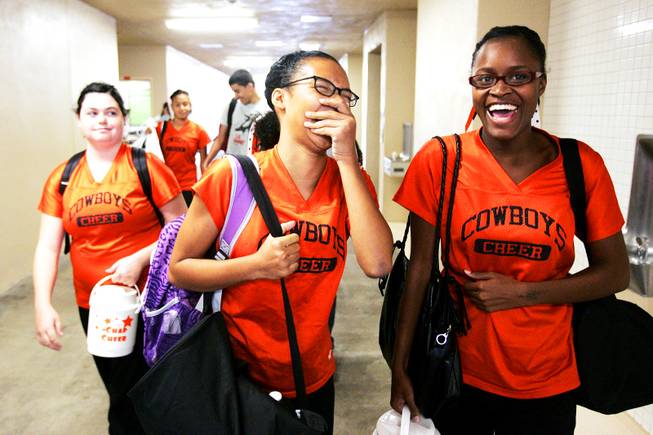
Seniors Elsha Harris, center, and Crystal Carter, right, walk down the hall between classes at Chaparral High School in Las Vegas Thursday, September 8, 2011.
Thursday, Sept. 15, 2011 | 2 a.m.
The Turnaround: Chaparral High School
KSNV examines the Clark County School District's turnaround efforts at Chaparral High School.
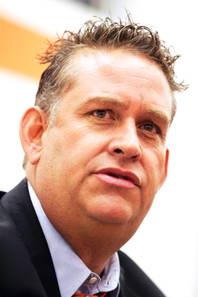
David Wilson, principal of Chaparral High School, on Thursday, August 18, 2011.
This is another in a yearlong series of stories tracking efforts by the Clark County School District to improve student performance at five struggling schools.
Elsha Harris-Yolanda and Crystal Carter are having a hard time adjusting to the new sheriff in town at Chaparral High School.
The teenagers seem to be exemplary students — not the kinds who might find themselves in the cross hairs of a new principal who is charged with pulling Chaparral out of Clark County School District’s worst-performing list.
Elsha, who has a 3.2 GPA, and Crystal, who gets almost straight A’s, are athletes, cheerleaders and involved in student government. They’re talking about college and the workplace. They would seem to be the kind of students Principal David Wilson would get the least push-back from.
But they don’t like what Wilson is up to.
The first week of school, Crystal said, “was horrible.”
New rules forbid students from using cellphones during the school day or wearing ear buds to listen to music. Students are locked out of classes if they are late and forbidden from taking restroom breaks during class periods. There’s a midday snack break, but lunch does not come until 1:40 p.m., the end of the school day, the better to chase off students who start fights, deal drugs and cause any of a dozen other problems.
Wilson, who arrived over the summer to run the campus, says his efforts to clamp down on campus behavior are justified.
Just three in 10 freshmen who entered the school five years ago graduated last year — one of the worst graduation rates in the county. Indeed, years of troubling results on standardized tests at the national, state and local levels contributed to the transfer of the school’s popular principal, Kevin McPartlin, and half of Chaparral’s staff, as the School District’s new leadership designated Chaparral as a turnaround school, making it eligible for federal grant money.
Elsha misses the old staff, saying McPartlin and his team had helped her overcome many challenges.
“I’m supposed to be a statistic. I’m supposed to be pregnant. I’m supposed to have dropped out of school. I’m not supposed to be where I am, but I am because I push myself, because I’ve had teachers who believed in me, because I’ve had coaches who believed in me,” Elsha says.
Wilson, it seems, is dealing with students who are beginning the year carrying a grudge. His challenge: Transform the campus into an academic winner, even if it means offending student sensibilities.
“Mr. McPartlin put the pride back in this school,” Crystal says. “He made me proud to go to Chap when (outsiders) said this school was ‘so ghetto’ or ‘you go to such a bad school.’ I would say: ‘No I don’t. Come and walk my halls. Come and see what I see. Have my experiences.’ ”
Now she worries about the new school year with all of its changes. “If this is what it’s going to be like for the rest of the school year, I really question if I want to be at this school,” she says. “This isn’t the school that I fell in love with.”
Wilson, who arrived after serving as principal of Virgin Valley High in Mesquite and a middle school in Moapa, understands the emotional tug that a school, particularly a high school, has on students.
“Change is difficult,” Wilson says. “Relationships are everything. Principals, teachers, I understand that, and I get it. But it keeps coming back to that No. 1 goal, graduating kids. The changes are all about graduating kids. I wish I had a different, more empathetic response, but it comes back to that No. 1 thing.”
Wilson and the principals of the School District’s four other newly designated turnaround schools — Mojave and Western High Schools, and Hancock and Elizondo Elementary Schools — attended a weeklong seminar at the University of Virginia’s Darden School of Management this summer for guidance on how to alter the culture, performance and results at academically troubled schools. Participation requires that each principal adopt a 90-day plan for the start of a school year.
LeAnn Buntrock, the program’s executive director, understands the emotions of students such as Elsha and Crystal, especially Crystal’s ties to Chaparral’s past principal and staff. “It’s like home for her, and that’s why David (Wilson) has to communicate a clear vision, that the changes aren’t because (any student) is being punished. There are still a number of kids who aren’t reaching their full potential, and we have to figure out ways to do that without putting down the reputation of the prior administration or teaching staff.”
There are emotional wounds to be healed, feelings to be calmed, but the focus must remain on students’ academic performance, which is more than a collection of standardized test scores, Buntrock notes. It is also about a child’s ability to read or perform math exercises at grade level, to think at higher levels, draw inferences from diverse material, to mesh concepts and not only grasp them but clearly explain their content to others.
“I don’t mean to boil it down to test scores, but when you’re part of an organization that has been chronically underperforming for several years, you are in need of a culture change because people become accustomed to operating in a certain manner,” Buntrock says.
The opportunity for change increases by 70 percent if new leaders are brought into a troubled school, Buntrock notes. “If you’ve been part of an organization for a long time it’s hard to come in one day and say, ‘You have to look at me differently; you have to look at the organization differently.’ ”
Buntrock’s program pushes the concept of “the quick win,” a rapid, positive transformation of a school that instantly grabs students, teachers, administrators, parents and the community.
For Wilson and Clark County Schools Superintendent Dwight Jones, Chaparral’s quick win came in the form of a $2 million investment in repairs to Chaparral’s battered physical plant. The school had few working toilets; filthy floors, walls and air ducts; deeply scarred windows; classrooms that required fresh paint; athletic fields and tennis courts that were torn up. School District work crews spent 80-hour weeks over a six-week period repairing the school, providing Wilson with what he described as a “wow” moment when students returned to what he has labeled: “The New Chap.”
Wilson’s administrative team also altered the class schedule, offering long and short classes in math, reading and other subjects, all designed to target teens with intensive instruction in classes where they have fallen behind.
Teachers meet in small groups to share some of the best practices in teaching math, reading, science and other subjects. Federal grant money has been used to bring in San Francisco consulting firm Teachscape, which offers classroom coaching to teachers with the aid of 360-degree cameras that allow teachers to see what they look like as they work.
Wilson has vowed to transfer teachers at the end of the third week if they fail to embrace and execute all aspects of the strategy. “Our No. 1 goal is to graduate those kids. That’s it,” Wilson says.
The new structure has shaken Crystal and Elsha, with the students feeling as though they are being punished for the school’s past academic performance. “I know we made mistakes last year, and sure those mistakes should be fixed, but it’s way too extreme,” Crystal says.
Wilson is aware of such concerns, but is confident that his changes will usher in a new culture of academic and social success at Chaparral. A week ago he visited every classroom in the school, inviting students to ask him questions about the transformation. He routinely walks the campus, fist-bumping teens before asking how they like the changes. Some say they do. Others do not. After his football team’s first game of the season, a 54-6 road loss to Moapa Valley High School, Wilson had the entire team to his home, where he and his wife, Karen, fed the boys and lit a huge bonfire in their backyard.
“People liked Kevin. Kevin’s very popular, and following him is not easy,” Wilson says of his predecessor. “I’m good at building relationships, so I’m not worried about it. Same thing with the teachers. Eventually the students will have built relationships with somebody else.”
Elsha remains cynical.
“A lot of the people who are coming back care about the school. We weren’t broken before, and it’s going to take time. You have to give it time, and I don’t think Mr. McPartlin or the old staff were given enough time. It’s just not fair.”
But what she says also gives Wilson hope:
“This is a new Chap for me, and I’m not saying it’s a bad Chap, but it’s not what I’m used to, and it’s going to take some time.”
Chaparral High School has seen better days.
Once among the top performing schools in the Clark County School District, Chaparral High is undergoing changes to counter dismal test scores and the lowest graduation rate in the district.
The campus located near East Flamingo Road and U.S. 95 is one of five turnaround schools not meeting the expectations outlined in No Child Left Behind.
Chaparral is now looking to clean up its reputation, touching every aspect of the school from restrooms to test scores.
Changes weren’t received well by students who openly protested the cuts to faculty and the new order that banned the use of cell phones and music players during the school day.
Under stricter rules, tardy students are locked out of classrooms, bathroom breaks during class time aren’t allowed and the lunch hour was pushed back to 1:40 p.m.
Superintendent Dwight Jones told students he’s not settling for half successes.
“Right now, 50 percent of the kids in this school don’t graduate high school. Is that acceptable to you? Think about that. Right now, some of the friends that you’re with aren’t going to graduate. Is that OK? That’s unacceptable to me. I think you guys ought to kick all of us out.”
- Year built:
- 1971
- Mascot:
- Cowboys
- Principal (Year Hired):
- David Wilson (2011)
- Enrollment:
- Approximately 2,250
- School Report Card:
- 2010-2011
Compiled by Gregan Wingert

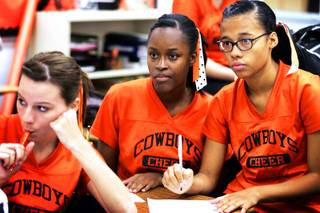
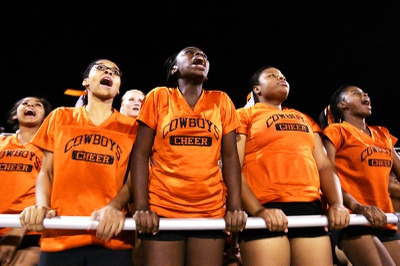
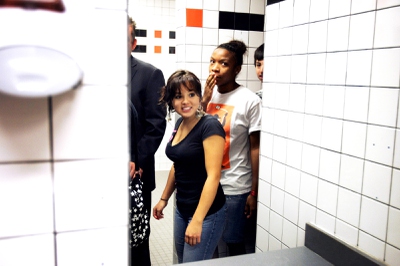

Join the Discussion:
Check this out for a full explanation of our conversion to the LiveFyre commenting system and instructions on how to sign up for an account.
Full comments policy